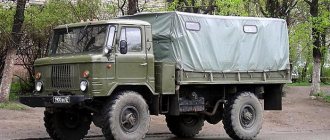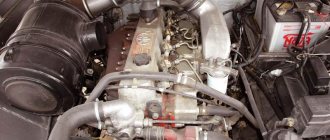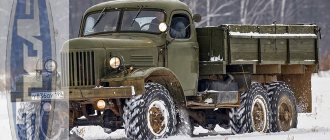GAZ 66 kung is a very popular Soviet car with a carrying capacity of about 2 tons, which is a technical continuation of the GAZ-62, which was produced earlier. However, the GAZ 66 diesel was used not only in the construction and agricultural industries, but also for military purposes, as it had relatively small dimensions, a huge cargo body capacity, and an engine that was located under the driver’s cab.
Classic view of a GAZ 66 truck with a kung
By the way, the diesel version appeared much later. Initially, the car was equipped only with a ZMZ gasoline engine with a carburetor.
Car modifications
Today, tuning the Kung GAZ 66 does not present any problems. Previously, the plant carried out modifications only after receiving a government order. And even then it was not tuning, but simply a different configuration. However, it is worth mentioning that in 1991 the GAZ-66-16 rolled off the production line, which was a direct modernization of the first-order car.
This is what the ZMZ-513 engine for GAZ-66 removed from conservation looks like.
For example, it used the ZMZ-513-10 engine, the GAZ 66 brakes were completely redesigned, the platform was used without wheel niches (and, accordingly, was more resistant to dynamic loads and off-road travel).
Thus, the GAZ 66 was removed from conservation and put back into production, since previously proposed options for new generations of trucks were rejected by the leadership of the Russian Federation. The technical characteristics of it have also changed somewhat:
- maximum power - 140 horsepower;
- engine capacity - 3.5 liters;
- load capacity - 2.3 tons;
- carburetor operation control system.
Option for tuning a GAZ 66 truck with a kung.
A similar design remained in the GAZ-66-21, but it used dual axles at the rear (6x6 wheelbase with the ability to disable the front ones), thanks to which the permissible load capacity was increased to 3.5 tons.
By the way, the GAZ-34, produced in the 70s, was a prototype, from which the GAZ-66-21 was later produced. The GAZ 66 Kung was first equipped with a diesel engine only in 1992 (without pressurization), but later the engineers themselves pointed out that this was not the best solution. The power dropped dramatically, and special boxes were needed to store the car. However, such conditions completely suited the defense industry, where most of the GAZ-66s are still in operation today.
Installed diesel engine on Gas 66 with a kung.
They are used both for transporting personnel and for installing non-portable surface-to-ground and surface-to-air missile launchers. Only in 1995, a ready-made modification with a turbodiesel was released, which in terms of performance was almost in no way inferior to gasoline engines. The turbo engine produced maximum power of 135 horsepower. No further “tuning” was performed by the manufacturer. They produced only cars oriented for export to countries with tropical climates.
GAZ 66 with kung currently
Oddly enough, the car is widely used to this day, mainly by government services and the army, despite its high fuel consumption and relatively low performance (when compared with Western counterparts). Unfortunately, due to the complexity of storage, the car is not used by the broad masses of consumers.
But the cab mounting system that was used in the GAZ-66 is still in great demand today. It was fastened with hinges and could move forward. The passenger seat (or sleeper seat, which was located immediately behind the driver) was non-removable, so it was not possible to gain access to the junction box.
Modern interior of a Gas 66 car with a kung
For this reason, those who become the owner of this car, first of all lengthen the body, leaving less space for the cargo.
In addition, the loading platform will need to be replaced, since it was made of high quality only in the 70-80s of the last century. Since the 90s, the quality of the metal used at the GAZ concern has changed dramatically for the worse. It must be said that in the basic configuration there was only one seat for the driver in the cabin.
The passenger compartment was hidden by a casing, under which the engine and other power units of the truck were hidden. When preserving the car for long-term storage, the casing needed to be sealed. For what purposes can a car be used at home? For transportation of large and oversized cargo, for transportation in total off-road conditions (since there is a switchable all-wheel drive), as well as for civil transportation (modification with a transmission for buses). Those cars that are used in agriculture are mainly converted to LPG with a carburetor. With such equipment, fuel consumption “shishigi” (as the car is popularly nicknamed) is reduced by almost 2 times, but the maximum power also becomes 90 horsepower.
Description of the base model
The platform for the GAZ-66 all-terrain vehicle was the GAZ-62, assembled in the fifties at the plant in Gorky.
This vehicle had a cabin design characteristic of that time with a fabric roll-up roof and removable door extensions.
The creators of the new all-wheel drive vehicle have retained the general layout of the cabin, located above the engine. Only now it has become all-metal.
The spare tire was placed vertically behind the cab, in front of the body. As a result, while the overall dimensions of the entire vehicle were shortened, it was possible to increase the size of the loading platform and lower its landing, thereby making loading/unloading easier.
The truck bed was made of metal with wooden slatted and folding sides on the rear side. The back had folding benches for transporting people.
The first basic GAZ-66-1 had a carrying capacity of two tons. Various modifications on this chassis were produced until the mid-eighties.
And here the technical characteristics of Kegel semi-trailers are described.
During this time, for the needs of the Armed Forces, agriculture and areas with difficult roads, such modifications were created as:
- "66A" with winch;
- “66E” or “66-03” - a machine whose equipment was shielded;
- modification intended for landing from a military transport aircraft, marked “66B” . It had a folding roof, a folding front frame with triplex and a RU with a folding column;
- single test samples - GAZ-4 with a 6x6 wheel arrangement and "66P" as a truck tractor.
A distinctive feature of the first GAZ-66-1 cars was the lack of automatic air pumping into the wheels.
In the mid-eighties, a modernized version of this all-terrain vehicle came off the assembly line under the label GAZ-66-11.
A compressor powered by the engine was installed on it to automatically maintain the required pressure in the wheels, which, according to reviews from the owners, is quite convenient.
Thanks to the technical characteristics of the car, such as a load capacity of four tons, it was possible to install KUNGs and special equipment in different configurations on the GAZ-66 base. In the books you can find the following car parameters:
- The geometric dimensions of the vehicle are 5,655 (without special equipment in the form of a winch) x 2,322 x 2,490 (in the cabin) in millimeters.
- Ground clearance is 315 mm.
- The largest possible weight of the machine is 5,940 kg.
- The wheelbase of this car is 3,300 mm, the track is 1,800 mm.
- The turning radius provides good maneuverability and is 9.5 meters, which is less than many smaller passenger cars.
- Eighteen-inch tires and sealed machine and engine units provide the ability to ford a depth of 80 cm.
- The transmission includes a synchronized gearbox with four gears and a transfer case with direct and reduction gears, which also has the ability to disengage the front axle.
Single disc clutch. Forces are transmitted using three shafts and six cardans.
Differentials have the ability to increase friction, cam type. Since the front wheels are driven, CV joints are used in their drive.
- Suspension front and rear is dependent, leaf spring. The ends of the springs are on rubber supports. Both axles have shock absorbers.
- Steering - worm with roller. A hydraulic booster is installed on the switchgear.
- The drive of the brake system is made with a hydraulic vacuum booster. Brakes on wheels are of shoe type.
- Starter ST-130B, battery 6-ST66-EM. On-board voltage is 12V.
- The fuel tanks can hold 210 liters.
Design features of the transfer case
The transfer case on a car is designed to amplify torque and distribute it, as well as transmit it to the front and rear axles.
In addition, the RC “66-11” has a design for disabling and engaging the front drive axle. Structurally, it includes:
- a drive shaft on which there is a movable gear for connecting direct and reduction gears;
- intermediate shaft . It also has gears. One wheel engages a downshift, the second, movable, serves to engage axles;
- there is a drive shaft for the rear axle ;
- front axle drive shaft;
- control mechanism having shift levers and rods.
Transfer cases for GAZ-66 today are sold at prices starting from 12 thousand rubles.
List of other models
Below is a list of some other modifications of the truck in question:
- 1991 - northern variation with an additional heater and a cabin with paired windows;
- 1992-1994 - GAZ-66-22 (national economic version with an on-board platform);
- 1992-1994 - model 31 (chassis for mounting dump bodies, equipped with a power take-off unit);
- 1995-1998 - version under the index 40 (truck with an onboard platform and a turbine diesel engine);
- 1985-1996 - low GAZ-66 KUNG, the dimensions of which corresponded to version 11, was used to create rotational buses.
Specialized equipment based on the machine in question:
- ambulance for transporting the wounded;
- disinfection machine;
- transport for medical dressing;
- oil filler;
- command and staff version;
- postal and grain vans;
- mobile workshops;
- dump trucks for the agricultural sector;
- pontoon landing park;
- mobile clinics;
- buses PAZ-3201, Volgar, 38-AS.











